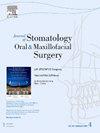口腔癌动脉内化学放疗:调强放疗优于三维适形放疗。
IF 1.8
3区 医学
Q2 DENTISTRY, ORAL SURGERY & MEDICINE
Journal of Stomatology Oral and Maxillofacial Surgery
Pub Date : 2024-10-01
DOI:10.1016/j.jormas.2024.101981
引用次数: 0
摘要
目的:确定在接受动脉内化学放疗的口腔癌患者中,调强放射治疗(IMRT)优于三维适形放射治疗(3DCRT):我们回顾性分析了2010年至2021年间在一家机构接受动脉内放化疗的局部晚期口腔癌患者。所有在 2015 年 5 月之后接受治疗的患者均接受了 IMRT。多西他赛(12 毫克/平方米/周)和奈达铂(5 毫克/平方米/天)使用导管通过颞浅动脉给药:共有143名患者(IMRT:71人;3DCRT:72人)参与了这项研究。5年总生存率(OS)和无进展生存率(PFS)分别为75.7%和59.8%,两种照射方法之间无显著差异。在多变量分析中,宫颈淋巴结转移(LNM)是影响OS、PFS、局部控制(LRC)和局部控制(LC)的唯一重要不良预后因素。在对LNM病例(90例)进行的多变量亚组分析中,IMRT有助于提高LRC(危险比[HR]=0.4,P=0.01)和LC(HR=0.4,P=0.006)。IMRT组和3DCRT组之间≥2级颌骨坏死(4.2% vs. 12.5%,P=0.13)、口干(75% vs. 82%,P=0.316)或口臭(80% vs. 82%,P=0.834)的发生率没有差异。然而,IMRT 组患者 6 个月时的口干症发生率和 3 个月时的吞咽困难发生率较低(均为 PC结论:IMRT既没有提高患者的生存率,也没有显著降低颌骨坏死的发生率。然而,IMRT在LNM患者的LRC和LC方面表现良好,这表明它在早期恢复口腔排泄和口腔异味方面具有优势。本文章由计算机程序翻译,如有差异,请以英文原文为准。
Intra-arterial chemoradiotherapy for oral cancer: Superiority of intensity-modulated radiation therapy over three-dimensional conformal radiation therapy
Purpose
To determine the superiority of intensity-modulated radiation therapy (IMRT) over three-dimensional conformal radiation therapy (3DCRT) in patients who underwent intra-arterial chemoradiotherapy for oral cancer.
Methods
We retrospectively analyzed patients with locally advanced oral cancer curatively treated with intra-arterial chemoradiotherapy at a single institution between 2010 and 2021. All patients treated after May 2015 underwent IMRT. Docetaxel (12 mg/m2/week) and nedaplatin (5 mg/m2/day) were administered through a shallow temporal artery using a catheter.
Results
In total, 143 patients (IMRT: 71; 3DCRT: 72) were included in this study. The 5-year overall survival (OS) and progression-free survival (PFS) rates were 75.7 % and 59.8 %, respectively, with no significant differences between the irradiation methods. In multivariate analysis, cervical lymph node metastasis (LNM) was the only significant poor prognostic factor contributing to OS, PFS, locoregional control (LRC), and local control (LC). In multivariate subgroup analysis of LNM cases (n = 90), IMRT contributed to favorable LRC (hazard ratio [HR]=0.4, P = 0.01) and LC (HR=0.4, P = 0.006). There was no difference in the incidence of grade ≥2 osteonecrosis of the jaw (4.2 % vs. 12.5 %, P = 0.13), xerostomia (75 % vs. 82 %, P = 0.316), or dysgeusia (80 % vs. 82 %, P = 0.834) between the IMRT and 3DCRT groups. However, the rates of xerostomia at 6 months and dysgeusia at 3 months were lower in the IMRT group (both P < 0.001).
Conclusion
IMRT neither improved patient survival nor significantly reduced the incidence of osteonecrosis of the jaw. However, it demonstrated favorable LRC and LC in patients with LNM, suggesting an advantage in early recovery from xerostomia and dysgeusia.
求助全文
通过发布文献求助,成功后即可免费获取论文全文。
去求助
来源期刊

Journal of Stomatology Oral and Maxillofacial Surgery
Surgery, Dentistry, Oral Surgery and Medicine, Otorhinolaryngology and Facial Plastic Surgery
CiteScore
2.30
自引率
9.10%
发文量
0
审稿时长
23 days
 求助内容:
求助内容: 应助结果提醒方式:
应助结果提醒方式:


